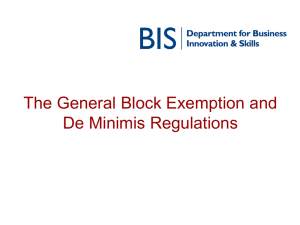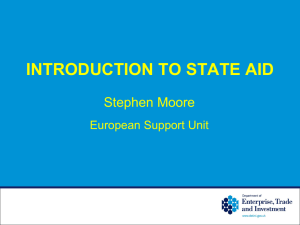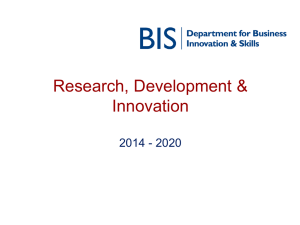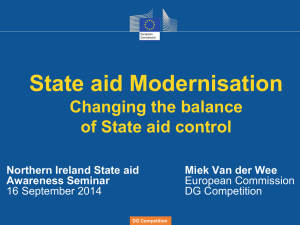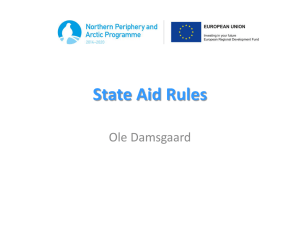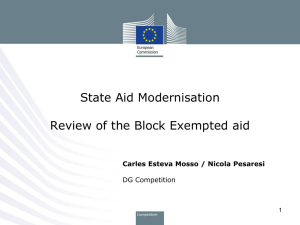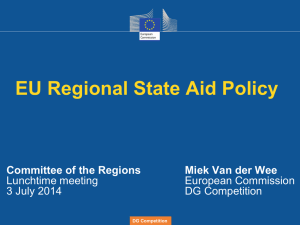DOC - Europa
advertisement
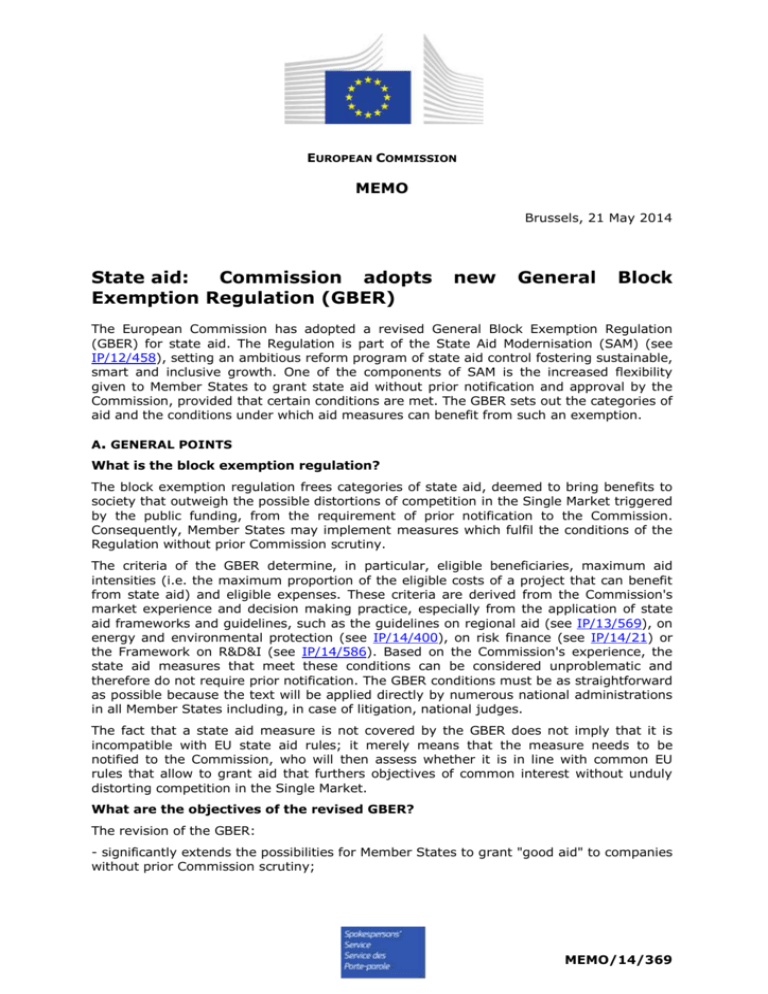
EUROPEAN COMMISSION MEMO Brussels, 21 May 2014 State aid: Commission adopts Exemption Regulation (GBER) new General Block The European Commission has adopted a revised General Block Exemption Regulation (GBER) for state aid. The Regulation is part of the State Aid Modernisation (SAM) (see IP/12/458), setting an ambitious reform program of state aid control fostering sustainable, smart and inclusive growth. One of the components of SAM is the increased flexibility given to Member States to grant state aid without prior notification and approval by the Commission, provided that certain conditions are met. The GBER sets out the categories of aid and the conditions under which aid measures can benefit from such an exemption. A. GENERAL POINTS What is the block exemption regulation? The block exemption regulation frees categories of state aid, deemed to bring benefits to society that outweigh the possible distortions of competition in the Single Market triggered by the public funding, from the requirement of prior notification to the Commission. Consequently, Member States may implement measures which fulfil the conditions of the Regulation without prior Commission scrutiny. The criteria of the GBER determine, in particular, eligible beneficiaries, maximum aid intensities (i.e. the maximum proportion of the eligible costs of a project that can benefit from state aid) and eligible expenses. These criteria are derived from the Commission's market experience and decision making practice, especially from the application of state aid frameworks and guidelines, such as the guidelines on regional aid (see IP/13/569), on energy and environmental protection (see IP/14/400), on risk finance (see IP/14/21) or the Framework on R&D&I (see IP/14/586). Based on the Commission's experience, the state aid measures that meet these conditions can be considered unproblematic and therefore do not require prior notification. The GBER conditions must be as straightforward as possible because the text will be applied directly by numerous national administrations in all Member States including, in case of litigation, national judges. The fact that a state aid measure is not covered by the GBER does not imply that it is incompatible with EU state aid rules; it merely means that the measure needs to be notified to the Commission, who will then assess whether it is in line with common EU rules that allow to grant aid that furthers objectives of common interest without unduly distorting competition in the Single Market. What are the objectives of the revised GBER? The revision of the GBER: - significantly extends the possibilities for Member States to grant "good aid" to companies without prior Commission scrutiny; MEMO/14/369 - simplifies the award of state aid and reduces the duration of processes for aid beneficiaries; - introduces ex-post requirements for Member States such as the requirement to evaluate large aid schemes and introduce more transparency on aid measures. The new GBER is a cornerstone of the State Aid Modernisation agenda (see IP/12/458), which is a broad reform of state aid rules aimed at facilitating sustainable, smart and inclusive growth, focusing on cases with the biggest impact on the internal market and streamlining the rules to adopt faster and better informed decisions. The review of the GBER contributes to all SAM objectives, with a particular focus on simplification and dealing as a priority with cases that matter most for competition in the Single Market. What will be the impact of the GBER? The GBER is already used (to a varying extent) by aid granting authorities (i.e. national governments, as well as regional and local authorities). In the future, 3/4 of today's aid measures and about 2/3 of total aid amounts granted by Member States could be covered by the new GBER. This could even extend to up to 90% of all aid measures, if Member States use the GBER to the full extent by designing their measures in order to fit its requirements. This means that only the cases with the biggest potential to distort competition will remain for ex-ante assessment by the Commission before they can be granted to beneficiaries (notification). This increased use of the GBER will have a strong impact on aid beneficiaries and on granting authorities, as it will allow for immediate access to aid (no notification, no prior compatibility assessment) and a lower administrative burden. This can also contribute to easier absorption of structural funds, when projects are funded in such a way. Member States will have a major role in designing and implementing schemes without prior notification. What are the main new elements of GBER? The adoption of an amended Enabling Regulation (see IP/13/728) enabled the Commission to exempt more categories of aid from the notification requirement. In line with its experience and decision making practice and after a public consultation (see IP/13/736), the Commission has included the following new categories of aid in the GBER: - aid to innovation clusters and aid to process and organisational innovation, - aid schemes to make good the damage caused by natural disasters, - social aid for transport residents of remote regions, - aid for broadband infrastructure, - aid for culture and heritage conservation, including aid schemes for audio-visual works, - aid for sport and multifunctional recreational infrastructures, - investment aid for local infrastructure. As from 1 July 2014, aid measures designed in line with the provisions of the GBER in all these categories do not need to be notified to the Commission any longer before being implemented. Moreover, categories which were already covered by the previous GBER are broadened – in other words, new forms of exempted aid are allowed: - a wider scope for risk finance aid, 2 - investment aid for research infrastructure, - a new simplified provision on start-up aid, - environmental aid categories: aid for the remediation of contaminated sites, district heating and cooling, waste management, operating aid for electricity from renewable sources, energy infrastructures, - a wider definition of the notion of disadvantaged workers for employment aid to the youngest, - aid for compensating the costs of assistance provided to disadvantaged workers, - regional operating aid for outermost regions and sparsely populated areas and for urban development schemes. The new GBER also sets higher notification thresholds and aid intensities, for instance: - R&D projects notification thresholds are doubled (see also MEMO/14/368), - risk finance: the previous annual tranches of €1.5 million are replaced by a total limit that an eligible undertaking can receive of €15 million (see also IP/14/21), - for investment aid for sports and multifunctional infrastructures: EUR 15 million or the total costs exceeding EUR 50 million per project and for investment aid for culture and heritage conservation: EUR 100 million per project; How will the Commission check the compliance of all these measures with the GBER? To ensure a uniform level of compliance with the criteria of the GBER and limit distortions of competition in the Single Market, the significant increase in exempted aid measures is balanced by several safeguard mechanisms: - Transparency: national public registers of individual aid awards will ensure peer review and greater accountability (see also IP/14/588). - Monitoring: strengthened ex post-controls of compliance with the formal conditions for exemption. - Evaluation: collecting solid evidence will help designing smarter schemes with a better incentive effect (i.e. ensuring that the aid does not simply subsidise a project that the beneficiary would have undertaken without the support) and less competition distortions. What is state aid evaluation? Which state aid schemes will be evaluated? In a nutshell, evaluation aims at verifying whether the assumptions and conditions underlying the compatibility of an aid scheme have been complied with, whether its objectives have been realised and what impact it had on competition and trade. The following aid categories will be subject to an evaluation: regional aid (except operating aid), aid for SMEs, aid for access to finance for SMEs, aid for R&D&I, aid for environmental protection (except reductions of environmental taxes under Directive 2003/96/EC) and aid for broadband infrastructures. Within these categories, evaluation will be required only for large aid schemes, with an average annual budget exceeding €150 million. Schemes covered by the GBER but related to other categories of aid will not be subject to evaluation requirements, regardless of their budget. Successors to evaluated schemes should be notified in order for evaluation results to be taken into account both by the Member State and by the Commission. 3 According to simulations based on previous experience, only a limited number of aid schemes per year should qualify for evaluation under these requirements. This will ensure that the evaluation exercise remains proportionate. How evaluation will work in practice? GBER schemes subject to evaluation can be implemented without prior notification to the Commission. However, for such schemes the exemption will be limited to an initial period of six months following their entry into force. The Commission may extend this period upon approval of an evaluation plan that the Member State should notify not later than 20 working days after the entry into force of the scheme. The evaluation plan should contain some standard information (e.g. objectives of the aid scheme, result indicators, envisaged methodology, timeline of the evaluation). The Commission will provide detailed guidance on the content of an evaluation plan (on which a public consultation already took place – see IP/13/1146) and the templates. B. THE AID MEASURES PROMOTED BY THE GBER What measures are included in the GBER? - Regional aid: The GBER can make an important contribution to the EU's cohesion objectives. In addition to exempting investment aid, a new provision exempts for the first time regional operating aid to address the specific handicaps of outermost regions and sparsely populated areas. Such aid may be granted to compensate for additional transport costs of goods (in outermost regions and sparsely populated areas) and for additional operating costs other than transport costs (for outermost regions). Moreover, in view of the importance of urban development in terms of economic, social and territorial cohesion, aid to urban development projects up to €20 million, implemented through urban development funds in assisted regions and co-financed by the European Structural and Investment Funds (ESIF) is also exempted. - Aid for SMEs: SMEs can benefit from any category of aid covered by the GBER. In addition, the section on aid to SMEs, designed specifically for SMEs, covers investment aid, aid for consultancy services, aid for participation in fairs and a new category: aid for cooperation costs incurred by SMEs participating in European territorial Cooperation projects. On the basis of these provisions, SMEs can benefit from public support of up to €7,5 million. - Aid for access to finance for SMEs: to allow Member State to boost SME's access to finance, the revised GBER now covers a much wider range of companies, irrespective of their geographical location, including not only SMEs from seed/start up and expansion stages but also SMEs in later growth stages. To better align with market practices and adapt the funding to the needs of eligible SMEs, the limit of annual funding tranches of €1.5 million has been replaced by an overall limit of funding of €15 million per company. The range of possible instruments and funding architectures has also been widened including equity, quasi-equity, loans and guarantees, to better reflect market practices. New provisions for aid to alternative trading platforms and aid for scouting costs have been added. The provisions on aid for start-ups have also been simplified. - Aid for research, development and innovation: The GBER acknowledges that targeted aid for research, development and innovation can play a significant role in economic growth. The notification thresholds have been doubled for research and development projects. The conditions for support for prototypes and pilot projects has been simplified and streamlined. New categories of exempted aid cover innovation 4 clusters, research infrastructures and aid for process and innovation. Finally, the provisions on innovation for SMEs have been simplified. - Training aid: from 2007 to 2012, Member States granted around 90% of training aid under the GBER. This indicated that there was no need of major modifications in that category. One important novelty is that the distinction between general and specific training is abolished, which should further simplify the use of these provisions. - Aid for disadvantaged workers and for workers with disabilities: The new GBER extends the scope of the exemption for aid for the recruitment and employment of disadvantaged and disabled workers. In particular, the definition of disadvantaged workers now also applies to young people of 15-24 years old in order to reflect their difficulties to access the labour market in the current economic crisis. The Commission is committed to defending the rights of workers with disabilities. The GBER's provisions on aid to these workers worked well in the past and are largely retained. The scope of eligible costs in aid for compensating the additional costs of employing workers with disabilities has been enlarged (now extending e.g. to the costs of training staff to assist workers with disabilities, costs directly linked to the transport of workers with disabilities to the working place). - Aid for environmental protection: reflecting the principles of the guidelines on State aid for environmental protection and energy, the GBER contains provisions to help Member States meet their Europe 2020 climate targets, to gradually move to market based support for renewable energy and to incentivise companies to take early steps to meet European standards (see also IP/14/400). New categories include a provision allowing aid for up to 100% of the costs of remediating contaminated land, operating aid for the production of renewable electricity and operating aid for small scale renewable energy installations. Also, in order to facilitate the rehabilitation of buildings, a new possibility to grant support without notification is now available to Member States to allow then to leverage scarce public funds that may be available in this area. A new possibility to grant aid for waste recycling is also included in the Regulation. - Aid to make good damages caused by certain natural disasters: A new category has been introduced to allow for the compensation of damages caused by certain natural disasters, provided the competent public authorities of a Member State have formally recognised the character of the event as a natural disaster and there is a direct causal link between the natural disaster and the damages suffered by the company. - Social aid for transport for residents of remote regions: A new category has been introduced to allow for aid supporting end-consumers of air or maritime transport linking an airport or a port in a remote region with another airport or port within the EEA. - Aid for broadband infrastructure: The GBER exempts aid to “white” and “white NGA” areas (i.e. areas where no relevant broadband operator exists or is likely to invest in the next three years), but excludes block exemption for aid to “grey” or "grey NGA areas", where potential competition concerns need to be analysed very carefully. The requirements of an open tender for selecting the beneficiaries of aid, of fair and non-discriminatory wholesale access to the supported network and of full and effective unbundling ensure maximum competitive benefits. This category of aid should be seen in connection with the Commission's broadband guidelines (see IP/12/1424). - Aid for culture and heritage conservation: This is a new category of aid in the GBER - which covers a wide scope of cultural purposes and activities. The support can take the form of investment or operating aid. The block exemption will cover the vast majority of aid granted by Member States in support of this objective. 5 - Aid to schemes for audio-visual works: The GBER will cover the vast majority of audio-visual aid schemes and a large number of beneficiaries. The compatibility conditions set out in the GBER are based on the Cinema Communication (see IP/13/1074). - Aid for sport and multinational recreational infrastructures: The new GBER introduces this new category of support which may take form of investment or operating aid. Key compatibility condition is that access to infrastructures must be open to several users and be granted on a transparent and non-discriminatory basis. - Aid for local infrastructure: This new category of aid supports the construction or upgrade of infrastructure which has a local effect and which made available to users on an open, transparent and non-discriminatory basis. Such infrastructure plays an important role in fostering economic and social development and job creation at the local level. The text of the GBER is available at: http://ec.europa.eu/competition/state_aid/legislation/block.html#gber 6
